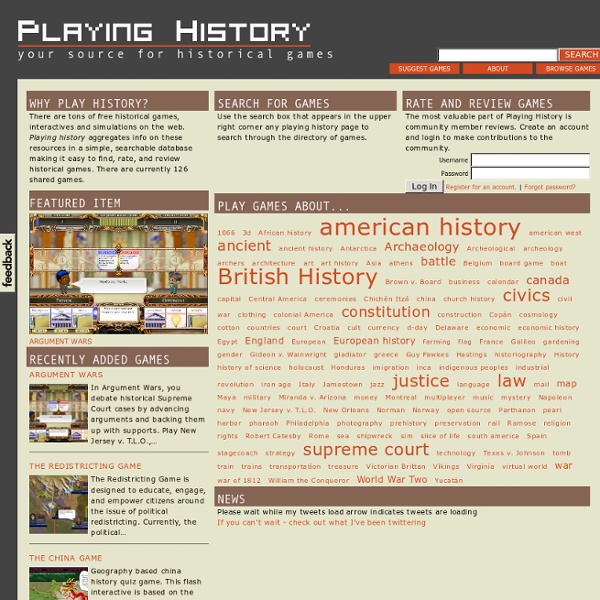



http://www.playinghistory.org/
Main Page The Internet Ancient History Sourcebook has expanded greatly since its creation, and now contains hundred of local files as well as links to source texts throughout the net. See Introduction for an explanation of the Sourcebook's goals. See the Help! page for all the help on research I can offer. Although I am more than happy to receive notes if you have comments on this web site, I cannot answer specific research enquiries [and - for students - I cannot, or rather will not, do your homework.] The Ancient History Sourcebook works as follows: via Facebook Shoes Passion | via Facebook | We Heart It Facebook Also found in these collections You might like these too Log in and add tags to this image to see more things you might like!
North Carolina History: A Digital Textbook - LEARN NC Primary sources, multimedia, readings, and lesson plans to tell the many stories of North Carolina's past. Replace your textbook — or enhance your teaching with selections. Get started Sampler An overview with samples of the kinds of readings, primary sources, and multimedia available. Educator’s Guides The World Factbook People from nearly every country share information with CIA, and new individuals contact us daily. If you have information you think might interest CIA due to our foreign intelligence collection mission, there are many ways to reach us. If you know of an imminent threat to a location inside the U.S., immediately contact your local law enforcement or FBI Field Office. For threats outside the U.S., contact CIA or go to a U.S. Embassy or Consulate and ask for the information to be passed to a U.S. official.
Ancient Civilizations To borrow from Dr. Seuss's book title, "Oh the Places You'll Go! Here's a coming attraction of the people, places, ideas, and things coming at you: Your 3.2 million-year-old human ancestor Lucy, mummies, pyramids, Cleopatra, "an eye for an eye", the birth of major religions Judaism, Christianity, Islam, Hinduism, and Buddhism, the birth of democracy, the first Olympics, Julius Caesar, gladiators, the invention of writing, paper, and the wheel, kingdoms built of stone in Africa, the Great Wall of China, the introduction of such concepts as zero, time, and monotheism (the belief in one god), Samurai, martial arts, palaces of gold, and even the Sphinx. Whew! The study of ancient civilizations and people raises some profound questions. Who are humans?
Mesopotamia Halsall Home | Medieval Sourcebook | Modern History Sourcebook Other History Sourcebooks: African | East Asian | Indian | Islamic | Jewish | LGBT | Women's | Global | Science See Main Page for a guide to all contents of all sections. Common Issues: Mesopotamian/Egyptian/Hebrew/Greek History 10 Most Fascinating Tombs in the World There is perhaps nothing else so distinctive of the condition and character of a people as the method in which they treat their dead. - William Tegg, 1876 Throughout the history of human civilization, different cultures mourn and treat the dead differently. Some, like Tibetan Buddhists, have no use for burials as they dispose the dead by feeding corpses to vultures or by burning them in funeral pyres. Most cultures, however, show their respect by burying the dead, sometimes in complex and ornate tombs, crypts, and catacombs.
DISCOVERY: A Simulation of Early American Colonization - Interact Simulations Divided into separate "colonies," teams of students face problems typical of life in 17th-century America and try to ensure the success of their settlements. After deciding on cargo and using map skills to cross the sea and select their sites, students—playing such roles as colony leaders, bankers, mappers, traders, and recorders—are pressed to make decisions concerning the division of labor, the role of government, and defense against possible Indian attack. Interaction among the colonies results in trading, alliances, and sometimes conflict, while Fate Cards affect each colony's success or failure. The wealthiest colony after 15 rounds of play wins.
History of Israel and Palestine T he Palestinian Jews were forced to form an organized defense against the Arabs Palestinians.... thus was formed the Hagana , the beginnings of the Israeli Defense Forces [IDF]. There was also a Jewish underground called the Irgun led by Menachem Begin (who later became Prime Minister of Israel). Besides fighting the Arabs, the Irgun was instrumental in driving out the pro-Arab British. Finally in 1947 the British had enough and turned the Palestine matter over to the United Nations.
Math Trainer - Times Tables Get in some serious math training. Responds to your answers, so it trains your weaknesses. Train yourself to remember, don't count (the cutoff time helps with this) New Version! (Note: the old version is here.) 5 B.S. Renaissance Myths You Learned in History Class #2. Renaissance Rome Was Not a Magnificent Cultural Center Hemera Technologies/AbleStock.com The Myth: Europe’s Top 25 Castles – The Best Castles in Europe There is something about castles that inspires awe and at the same time touches a gentler, more romantic side in each of us. And if you want to visit and tour some of the best castles in the world, then Europe should be your destination as this continent certainly has more than its share. Here are the top 25 castles in Europe, in no particular order.